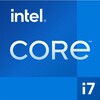Intel Core i7-1360P vs Apple M1 Max vs Intel Core i7-1370P
Intel Core i7-1360P
► remove from comparison
The Intel Core i7-1360P is a higher-end Raptor Lake-P (Alder Lake-P refresh) family CPU, an expensive 28 W part meant for use in ultra-light, ultra-thin (yet actively cooled) laptops. This CPU was announced in early 2023 and it has 4 of the 6 performance cores (P-cores, Golden Cove architecture) and 8 efficient cores (E-cores, Gracemont architecture). The P-cores are Hyper-Threading-enabled for a total of 16 threads when combined with the E-cores. The P-cores clock from 2.2 GHz (base) to 5 GHz (single core boost) and the E-Cores from 1.6 to 3.7 GHz.
Performance
The average 1360P in our extensive database is in the same league as the Ryzen 7 PRO 6850U, as far as multi-thread benchmark scores are concerned. Which is a pretty good result, as of mid 2023.
Thanks to its decent cooling solution and a long-term CPU power limit of 40 W, the NUC 13 Pro Kit NUC13ANK is among the fastest systems built around the 1360P that we know of. It can be more than two times as fast in CPU-bound workloads as the slowest system featuring the same chip in our database, as of August 2023.
The CPU still only supports PCIe 4.0 x8 for a GPU and two PCIe 4.0 x4 for SSDs.
The i7-1360P is rated at 28 Watt tDP (PL1, 64 Watt PL2 for short bursts). The CPU is manufactured in the further improved Intel 7 process (10nm SuperFin).
Apple M1 Max
► remove from comparison
The Apple M1 Max is a System on a Chip (SoC) from Apple that is found in the late 2021 MacBook Pro 14 and 16-inch models. It offers all 10 cores available in the chip divided in eight performance cores (P-cores with 600 - 3220 MHz) and two power-efficiency cores (E-cores with 600 - 2064 MHz). There is no Turbo Boost for single cores or short burst periods. The cores are similar to the cores in the Apple M1.
The big cores (codename Firestorm) offer 192 KB instruction cache, 128 KB data cache, and 24 MB shared L2 cache (up from 12 MB in the M1). The four efficiency cores (codename Icestorm) are a lot smaller and offer only 128 KB instruction cache, 64 KB data cache, and 4 MB shared cache. CPU and GPU can both use the 48 MB SLC (System Level Cache). The efficiency cores (E cluster) clock with 600 - 2064 MHz, the performance cores (P cluster) with 600 - 3228 MHz.
The unified memory (32 or 64 GB LPDDR5-6400) next to the chip is connected by a 512 bit memory controller (200 GB/s bandwidth) and can be used by the GPU and CPU. This is the main difference to the M1 Pro and the CPU performance is quite similar.
The biggest difference to the M1 Pro is the bigger integrated GPU with 24 or 32 cores (up from 16).
Furthermore, the SoC integrates a fast 16 core neural engine, a secure enclave (e.g., for encryption), a unified memory architecture, Thunderbolt 4 controller, an ISP, and media de- and encoders (including two ProRes engines).
The M1 Pro is manufactured in 5 nm at TSMC and integrates 57 billion transistors. The peak power consumption of the chip was advertised around 30W for CPU intensive tasks.
Intel Core i7-1370P
► remove from comparison
The Intel Core i7-1370P is the flagship Alder Lake-P CPU, which is to say, an expensive 28 W part meant for use in ultra-light (yet actively cooled) laptops. This CPU will probably be announced in early 2023 and it has 6 performance cores (P-cores, Golden Cove architecture) mated to 8 efficient cores (E-cores, Gracemont architecture) according to a leak on Geekbench. The P-cores are Hyper-Threading-enabled for whopping 20 threads when combined with the E-cores. The clock speeds can reach up to 5.2 GHz for the performance cluster (1.9 GHz base speed) and 1.4 GHz to 3.9 GHz for the efficiency cluster. The CPU is quite similar to the older Core i7-1280P but probably offers higher clock speeds.
Full vPro feature set is supported by this Core i7 ("Enterprise" tier, allowing for remote device management).
Architecture
The i7 is a continuation of Intel's efforts to use the ARM-developed big.LITTLE technology for its own benefit. A single "little" Alder Lake core is supposed to be just as fast as a Skylake core (as found in the venerable Core i7-6700HQ among other options) which is six years old at this point. All of a Core i7-1280P's CPU cores enjoy access to 24 MB of L3 cache. The integrated memory controller supports up to 64 GB of LPDDR5-5200, DDR5-4800, LPDDR4x-4267 or DDR4-3200 RAM. Just like the other 12th Gen Intel Core processors, Core i7-1280P comes with Thread Director which is a new functionality designed to help Windows 11 decide which cores to use for what workload for best performance and efficiency possible. Hardware acceleration of AI algorithms is supported via GNA 3.0 and DL Boost (via AVX2). PCI-Express 5.0 support has not found its way into Alder Lake P processors, so users will have to be content with PCI-Express 4.0 for the time being. The CPU still only supports PCIe 4.0 x8 for a GPU and two PCIe 4.0 x4 for SSDs.
Please note this is not a user-replaceable CPU. It gets soldered permanently on to the motherboard (BGA1744 socket interface).
Performance
Multi-thread performance is most comparable to AMD Ryzen 9 5900HS, Ryzen 9 PRO 6950HS, Intel Core i9-11980HK. Which is impressive but comes with a catch; long-term performance sustainability will be rather poor unless the Power Limits are very high and the cooling solution is a truly capable one.
Graphics
The built-in graphics adapter in the form of the 96 EU Iris Xe running at up to 1.5 GHz has seen no change from what was built into the 11th Gen Tiger Lake-UP3 processors, like a i7-1165G7, which is hardly a downside as this iGPU is loaded with modern features such as AV1 video decoding capability and SUHD 4320p monitor support.
Power Consumption
The i7's base power consumption (also known as the default TDP value or PL1) is 28 W, with 64 W being its maximum Intel-recommended Turbo power consumption (also known as the PL2). The "Minimum Assured" power consumption is fairly high at 20 watts. All in all, an active cooling solution is nearly a must.
Core i7-1370P is built with Intel's third-gen 10 nm process marketed as Intel 7.
| Model | Intel Core i7-1360P | Apple M1 Max | Intel Core i7-1370P | ||||||||||||||||||||||||||||||||||||||||||||||||
| Codename | Raptor Lake-P | Raptor Lake-P | |||||||||||||||||||||||||||||||||||||||||||||||||
| Series | Intel Raptor Lake-P | Apple M1 | Intel Raptor Lake-P | ||||||||||||||||||||||||||||||||||||||||||||||||
| Series: Raptor Lake-P Raptor Lake-P |
|
|
| ||||||||||||||||||||||||||||||||||||||||||||||||
| Clock | 1600 - 5000 MHz | 2060 - 3220 MHz | 1400 - 5200 MHz | ||||||||||||||||||||||||||||||||||||||||||||||||
| L1 Cache | 1.1 MB | 2.9 MB | 1.2 MB | ||||||||||||||||||||||||||||||||||||||||||||||||
| L2 Cache | 10 MB | 28 MB | 11.5 MB | ||||||||||||||||||||||||||||||||||||||||||||||||
| L3 Cache | 18 MB | 48 MB | 24 MB | ||||||||||||||||||||||||||||||||||||||||||||||||
| Cores / Threads | 12 / 16 4 x 5.0 GHz Intel Golden Cove P-Core 8 x 3.7 GHz Intel Gracemont E-Core | 10 / 10 | 14 / 20 6 x 5.2 GHz Intel Golden Cove P-Core 8 x 3.9 GHz Intel Gracemont E-Core | ||||||||||||||||||||||||||||||||||||||||||||||||
| TDP | 28 Watt | 28 Watt | |||||||||||||||||||||||||||||||||||||||||||||||||
| Technology | 10 nm | 5 nm | 10 nm | ||||||||||||||||||||||||||||||||||||||||||||||||
| max. Temp. | 100 °C | 100 °C | |||||||||||||||||||||||||||||||||||||||||||||||||
| Socket | BGA1744 | FCBGA1744 | |||||||||||||||||||||||||||||||||||||||||||||||||
| Features | DDR4-3200/LPDDR4x-4266/DDR5-5200/LPDDR5-6400/LPDDR5x-6400 RAM, PCIe 4, Thr. Dir., DL B., GNA, vPro Ess., MMX, SSE, SSE2, SSE3, SSSE3, SSE4.1, SSE4.2, AVX, AVX2, BMI2, ABM, FMA, ADX, SMEP, SMAP, EIST, TM1, TM2, HT, Turbo, SST, AES-NI, RDRAND, RDSEED, SHA | ARMv8 Instruction Set | Thread Director | ||||||||||||||||||||||||||||||||||||||||||||||||
| iGPU | Intel Iris Xe Graphics G7 96EUs ( - 1500 MHz) | Apple M1 Max 32-Core GPU | Intel Iris Xe Graphics G7 96EUs ( - 1500 MHz) | ||||||||||||||||||||||||||||||||||||||||||||||||
| Architecture | x86 | ARM | x86 | ||||||||||||||||||||||||||||||||||||||||||||||||
| Announced | |||||||||||||||||||||||||||||||||||||||||||||||||||
| Manufacturer | ark.intel.com | ark.intel.com | |||||||||||||||||||||||||||||||||||||||||||||||||
| Transistors | 57000 Million |
Benchmarks
Average Benchmarks Intel Core i7-1360P → 100% n=14
Average Benchmarks Apple M1 Max → 101% n=14
Average Benchmarks Intel Core i7-1370P → 110% n=14
* Smaller numbers mean a higher performance
1 This benchmark is not used for the average calculation













